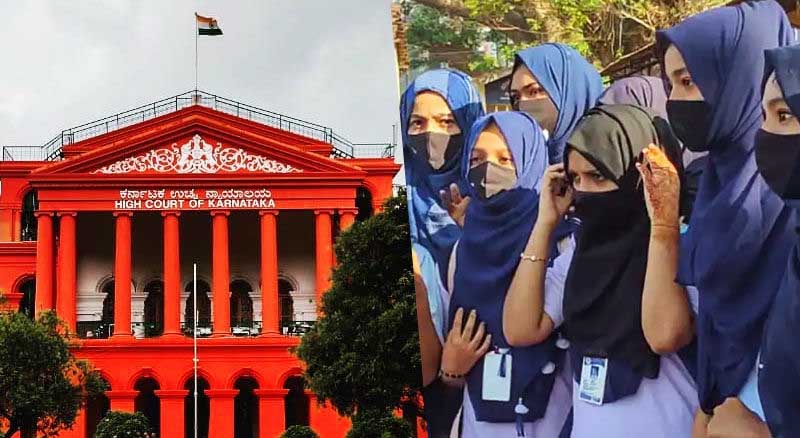
Image: Live Law
At the February 15 hearing before the Karnataka High Court, one of the Counsels, Mohammed Tahir brought to the court’s attention that the court’s order was being misused by the State as Muslim girls were being forced across the state to remove their hijab.
“In Gulbarga govt officials went to an Urdu school and forced the teachers and students to remove hijab,” he said. When it came to the court’s notice that the affidavit regarding this was filed by the Advocate himself and not by any petitioner, the bench comprising Chief Justice Ritu Raj Awasthi, Justice Krishna S Dixit and Justice J M Khazi said that it will be misconduct.
At the end of the hearing, the application was pressed once again and Tahir insisted that Civil rules permit lawyers to file an affidavit in certain circumstances, however, the court said it was not a correct practice and refused to allow it.
Public order
The Senior Advocate addressed the concern of the respondent that the Government Order (GO) was not properly translated and stated that the words “Sarvayanik suvyavaste” used in the GO is in fact, ‘public order’ since the official Kannada translation of the Constitution of India translates public order as “Sarvayanik suvyavaste” .
Justice Dixit interjected that the words in the GO cannot be read like a statute but Kamat persisted, “Very categorically sarvajyanik suvyavasthe means public order and it cannot have a different meaning. I rest my case there.”
Essential practice
Kamat cited Sardar Syedna Taher Saifuddin vs The State Of Bombay 1962 AIR 853 whereby the Supreme Court had struck down a Bombay law which prohibited ex-communication from a community on petitions by Bohra members stating that if it is essential practice, it must be upheld. The judgement states that “laws providing for social welfare and reform (are) not intended to enable the legislature to reform a religion out of existence or identity.”
South African court judgement
Kamat then cited Constitutional Court of South Africa’s judgement in KwaZulu-Natal and Others v Pillay [2007] ZACC 21 whereby the court held that “the rule prohibiting the wearing of jewellery had the potential for indirect discrimination because it allowed certain groups of learners to express their religious and cultural identity freely, while denying that right to others. The evidence before the Court showed that the wearing of a nose stud was a voluntary practice that formed part of Sunali Pillay’s South Indian Tamil Hindu culture, which itself was inseparably intertwined with Hindu religion.” In this case, the school had made similar arguments as are being made in the current case, that the Hindu girl had agreed to the school code, use of nose ring was not a popular practice, the ban on nose ring had no impact on her culture as she is free to wear it outside.
The judgement also noted, “Evidence shows that the nose stud is not a mandatory tenet of Sunali’s religion or culture; But the evidence does confirm that the nose stud is a voluntary expression of South Indian Tamil Hindu culture, a culture that is intertwined with Hindu religion.” The Chief Justice had also noted that “the removal (of nose ring) for a short time (while in school) will send a symbolic message that Sonali and her religion and culture are not welcome.”
Hijab not exemption but addition
Kamat quoted the South African judgment furthermore where it stated, “..this case is not about uniforms, but about exemptions to existing uniforms.” Kamat said that Hijab is not about uniforms either nor is it about exemptions but only an additional cloth over uniform.
“The admirable purposes that uniforms serve do not seem to be undermined by granting religious and cultural exemptions,” the judgment says.
In line with freedom of expression
Kamat reiterated that in India we follow positive secularism and that our secularism is from a Vedic perspective “Sarva Dharma Sama Bhava”. He submitted that wearing of headscarf is in line with right to freedom of speech and expression.
Plea for allowing headscarf
Kamat prayed once again before the judges to allow the girls to wear headscarves in educational institutions and to discontinue the interim order, “I respectfully submit that the sweep of your lordships order is extremely broad and it is in the teeth of Article 25 and other rights. Kindly make some leeway. In the meanwhile permit us to wear the head scarf in addition to uniform. Consideration will take time. This order in effect suspends fundamental rights. Kindly do not continue this interim order.”
No uniform decided by gov’t
Senior Advocate Ravivarma Kumar made submissions for another petitioner and pointed out to the court that the government had not made its final decision on the uniform dress code and it is yet to constitute a high level committee and thus, no uniform has been prescribed yet. “Kindly take note of the fact that there is no ban on wearing hijab by any student, much less by religious minority communities. GO says CDC will prescribe it. Till then, clothes which do not threaten public order, equality or unity must be worn, it says,” he submitted.
He further pointed out that the College Development Committee (CDC) was a non-existent body under the Education Act.
Related:
Hijab ban: Multiple Dimensions
Hijab controversy now hits schools!
How can a College Committee make decision on ‘public order’: Petitioners at Hijab Ban hearing